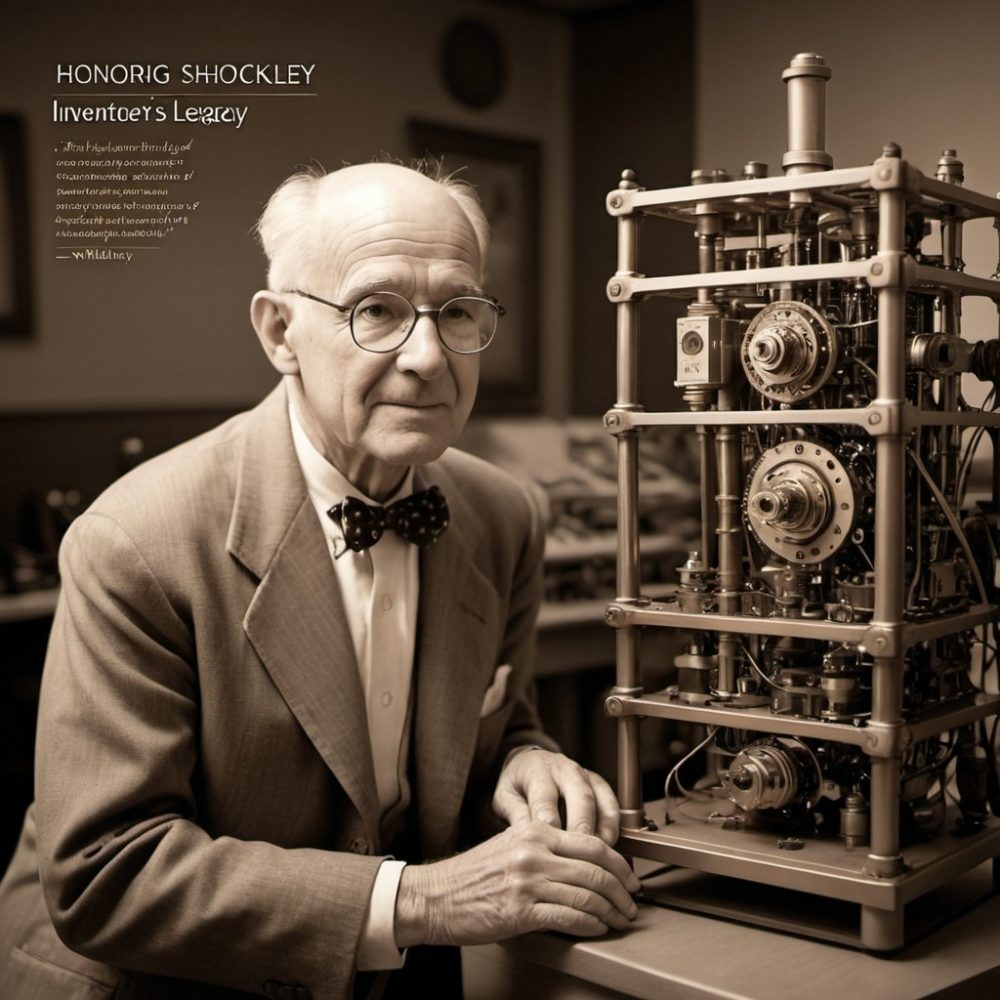
Honoring William Shockley: Inventor’s Legacy
The Legacy of William Shockley: A Trailblazer in Science
The Early Years
William Shockley’s journey into the world of science and innovation began in London, England, where he was born on the 13th of February, 1910. His parents, William Hillman Shockley and Mary (née Bradford), both had roots deeply planted in the mining industry, which perhaps sowed the seeds of exploration and discovery in young William.
The family’s move back to the United States in 1913 marked the start of a new chapter, setting the stage for William’s future achievements.
Education
William Shockley showed his academic talent early on. He studied in California. Then, he earned his B.Sc. degree at the California Institute of Technology. This institution sharpened his scientific curiosity and skills.
However, Shockley wanted more. He continued his studies at the Massachusetts Institute of Technology. There, he worked under Professor J.C. Slater. In 1936, he completed his Ph.D.
His thesis focused on the energy band structure of sodium chloride. Importantly, this work hinted at his future impact on semiconductor devices.
Early Career
After finishing his education, William Shockley joined Bell Telephone Laboratories. This place was a center for groundbreaking electronics research. Under Dr. C.J. Davisson’s guidance, Shockley started his career. He stayed at Bell Labs until 1955, except for short war service breaks.
During these years, he laid the groundwork for future achievements. Importantly, he helped develop the transistor. This device would revolutionize electronics.
A Prolific Career
World War II Service
During World War II, William Shockley played a crucial role. He fought against the Axis powers. As the Research Director of the Anti-submarine Warfare Operations Research Group, he used his scientific knowledge. Shockley contributed to the war effort. His versatility and dedication to his country were evident.
In 1946, he received the Medal for Merit. This award acknowledged his significant contributions, extending beyond pure science.
Semiconductor Research
After the war, William Shockley focused on semiconductor research. He left Bell Labs to lead the Shockley Semiconductor Laboratory. This move was crucial in his career. Shockley’s work on transistors and semiconductors sparked a tech revolution. His efforts were groundbreaking.
Consequently, he won the Nobel Prize for Physics in 1956. He shared this honor with John Bardeen and Walter H. Brattain. Their joint work on the transistor was the reason.
Academic and Advisory Roles
William Shockley’s career extended beyond research and development. In 1963, Stanford University named him the Alexander M. Poniatoff Professor of Engineering Science. There, he influenced the next generation of engineers and scientists.
Additionally, the U.S. government sought his expertise. He served on various scientific advisory panels. Through these roles, Shockley showed his dedication. He aimed to advance scientific knowledge for society’s benefit.
Legacy and Impact
Throughout his career, William Shockley earned many honors. These awards highlighted his impactful work. For instance, he received the Oliver E. Buckley Solid State Physics Prize and the Holley Medal.
Such honors acknowledged his contributions to solid-state physics and semiconductor devices, among others.
Moreover, several prestigious universities awarded him honorary doctorates. Consequently, these achievements solidified his position as a leading scientist.
Publications and Patents
William Shockley was more than a researcher. Additionally, he was an inventor and author. He published his book “Electrons and Holes in Semiconductors” in 1950. This book quickly became a foundational text.
Furthermore, Shockley held over 50 U.S. patents. His inventions significantly impacted our technology.
Today, this includes everything from computers to smartphones.
Personal Life and Final Thoughts
William Shockley achieved professional success. Yet, he faced personal challenges, including two marriages and a divorce. However, his legacy shines through his monumental contributions to science and technology.
His story showcases a relentless pursuit of knowledge. It proves the power of curiosity. And it reminds us how one person’s work can influence the future for many generations.
Explore Science Month’s Related Stories
Historical Figures and Their Contributions
- Physics: Battery, Atom, Sound, Waves, Particle
- Chemistry: Molecule
- Invention/Engineering: Telephone, Lightbulb
- Astronomy: Telescope
Past, Present, Future
- Foundations: Ancient India’s Pioneering Math Contributions
- Today’s Impact: ISRO Company: India’s Space Odyssey, S Somanath Inspires Science Month
- The Future: Artificial Intelligence: Transforming Everyday Moments
Science of Flavor
Curious Times is a leading newspaper and website for kids. We publish daily global news aligned to your learning levels (also as per NEP 2020): Foundational, Preparatory (Primary), Middle and Senior. So, check out the News tab for this. We bring kids’ favourite Curious Times Weekly newspaper every weekend with top news, feature stories and kids’ contributions.
ME – My Expressions at Curious Times is your place to get your work published, building your quality digital footprint. And it is a good way to share your talent and skills with your friends, family, school, teachers and the world. Thus, as you will step into higher educational institutes your published content will showcase your strength.
Communicate with us: Instagram.
0 (Please login to give a Curious Clap to your friend.)
SignUp to Participate Now! Win Certifiates and Prizes.

[…] Honoring William Shockley: Inventor’s Legacy […]
[…] William Shockley: Inventor’s Legacy […]
[…] William Shockley: Inventor’s Legacy […]
[…] William Shockley: Inventor’s Legacy […]
[…] William Shockley: Inventor’s Legacy […]
[…] William Shockley: Inventor’s Legacy […]
[…] William Shockley: Inventor’s Legacy […]
[…] William Shockley: Inventor’s Legacy […]
[…] William Shockley: Inventor’s Legacy […]